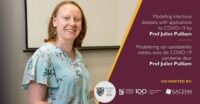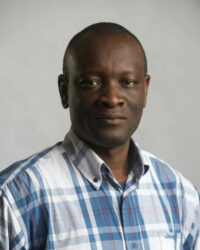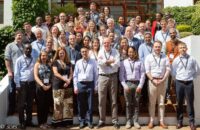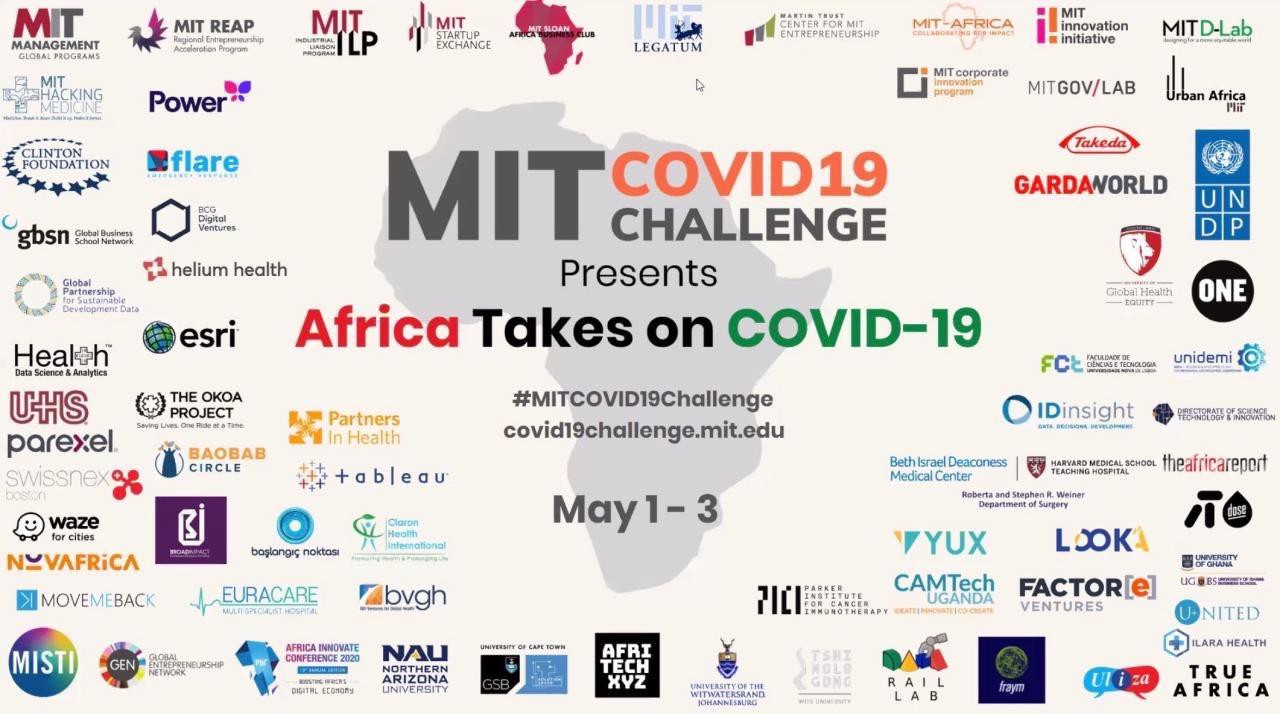SACEMA Newsletter: June 2020
SACEMA takes on COVID-19 virtually
 Zinhle Mthombothi, a SACEMA junior researcher, and Larisse Bolton, a SACEMA postdoctoral research fellow, took part in the MIT COVID-19 virtual ideathon, aimed at developing innovative solutions for the African COVID-19 crisis. Click here to read more.
Zinhle Mthombothi, a SACEMA junior researcher, and Larisse Bolton, a SACEMA postdoctoral research fellow, took part in the MIT COVID-19 virtual ideathon, aimed at developing innovative solutions for the African COVID-19 crisis. Click here to read more.
Use of Epidemiological Models during the COVID-19 pandemic
In studying infectious disease epidemics such as the current COVID-19 pandemic, models are often used to make short-term forecasts of case numbers and to evaluate the relative impact and effectiveness of potential options for intervention. Models are tools that help us formalise assumptions about the way the world works and explore the consequences of those assumptions. SACEMA researchers collaborating with colleagues at the London School of Hygiene and Tropical Medicine have developed a simple projection model to evaluate the early spread of COVID-19 in African countries, based on the timing of the first cases identified in each country. Click here to read more.
SACEMA’s director participates in SU’s first online Science Café
 SACEMA’s director, Prof Juliet Pulliam gave a talk entitled “Modelling infectious diseases, with applications to COVID-19” at Stellenbosch University’s first online Science Café. Click here to read more.
SACEMA’s director, Prof Juliet Pulliam gave a talk entitled “Modelling infectious diseases, with applications to COVID-19” at Stellenbosch University’s first online Science Café. Click here to read more.
COVID-19 Modelling Consortium
SACEMA researchers have been actively involved in assisting Government with their response to the COVID-19 outbreak in South Africa. SACEMA is part of the COVID-19 Modelling Consortium which provides projections to Government for the spread of the epidemic in South Africa.
The consortium is made up of researchers from the Modelling and Simulation Hub, Africa MASHA at the University of Cape Town, DSI-NRF Centre of Exellence in Epidemiological Modelling and Analysis SACEMA at University of Stellenbosch, the Health Economics and Epidemiology Research Office HE2RO at the University of Witswatersrand and the Boston University School of Public Health in the US, as well as the National Institute for Communicable Diseases NICD. The models are publicly available on the SACEMA’s website: https://sacemadev.sun.ac.za/resources
Subcommittee B Award for Young Researchers
 Dr Olatunji Adetokunboh, a National Public Health Liaison/Researcher with SACEMA was awarded Project Funding in the Young Researchers category by the Stellenbosch University Subcommittee B (Research Committee). The grant is to be used for the evaluation of the spatio-temporal trends in HIV prevalence in South Africa, Lesotho and Zimbabwe.The study will explore the geographic variables in conjunction with behavioral and demographic characteristics that are critical for improved surveillance systems in these countries. This study also has the potential for better understanding of HIV prevalence spatial patterns and will impact resource allocation for targeted public health interventions in the future.
Dr Olatunji Adetokunboh, a National Public Health Liaison/Researcher with SACEMA was awarded Project Funding in the Young Researchers category by the Stellenbosch University Subcommittee B (Research Committee). The grant is to be used for the evaluation of the spatio-temporal trends in HIV prevalence in South Africa, Lesotho and Zimbabwe.The study will explore the geographic variables in conjunction with behavioral and demographic characteristics that are critical for improved surveillance systems in these countries. This study also has the potential for better understanding of HIV prevalence spatial patterns and will impact resource allocation for targeted public health interventions in the future.
SACEMA Seminar Series
 On Friday 26 June 2020 SACEMA hosted its first online seminar. The seminar entitled “Challenges in Modelling SARS-CoV-2: Bridging the Best of Both Worlds Between Models and Reality” was presented by Dr Michael Li , a postdoctoral researcher at McMaster University in Canada and SACEMA research associate. In the talk Michael addressed the challenges in modelling and communicating risk in the earlier stages of the SARS-CoV-2 pandemic in Hubei, China. He also discussed patterns of delay distributions associated with COVID-19 healthcare in Ontario, Canada.
On Friday 26 June 2020 SACEMA hosted its first online seminar. The seminar entitled “Challenges in Modelling SARS-CoV-2: Bridging the Best of Both Worlds Between Models and Reality” was presented by Dr Michael Li , a postdoctoral researcher at McMaster University in Canada and SACEMA research associate. In the talk Michael addressed the challenges in modelling and communicating risk in the earlier stages of the SARS-CoV-2 pandemic in Hubei, China. He also discussed patterns of delay distributions associated with COVID-19 healthcare in Ontario, Canada.
Extinction probabilities as a function of temperature for populations of tsetse (Glossina spp.)
SACEMA PhD student Elisha Are and Senior Research Fellow, Prof John Hargrove published a manuscript in Plos Neglected Tropical Diseases on Extinction probabilities as a function of temperature for populations of tsetse (Glossina spp.)
Tsetse flies (Glossina spp) are the vectors of the African sleeping sickness. In this paper, we derived expressions for the extinction probability, and mean time to extinction, of closed populations of G. m. morsitans experiencing different levels of fixed temperature. Temperature plays a key role in tsetse population dynamics: no population of G. m. morsitans can escape extinction at constant temperatures < 16°C or > 32°C. The effect of temperature is more severe if tsetse populations are already depleted. Increasingly high temperatures due to climate change may alter the distribution of tsetse populations in Africa. The continent may witness local extinctions of tsetse populations in some places, and appearances in places hitherto too cold for tsetse.
Read the paper at https://doi.org/10.1371/journal.pntd.0007769
For more information contact: Elisha Are at elishaare@sun.ac.za
Calibration of individual-based models to epidemiological data: A systematic review
Calibration—that is, “fitting” the model to data—is a crucial part of using mathematical models to better forecast and control the population-level spread of infectious diseases. Evidence that the mathematical model is well-calibrated improves confidence that the model provides a realistic picture of the consequences of health policy decisions.
To make informed decisions, Policymakers need information about uncertainty: i.e., what is the range of likely outcomes (rather than just a single prediction). Thus, modellers should also strive to provide accurate measurements of uncertainty, both for their model parameters and for their predictions. This systematic review provides an overview of the methods used to calibrate individual-based models (IBMs) of the spread of HIV, malaria, and tuberculosis. We found that less than half of the reviewed articles used reproducible, non-subjective calibration methods. For the remaining articles, the method could either not be identified or was described as an informal, non-reproducible method. Only one-third of the articles obtained estimates of parameter uncertainty. We conclude that the adoption of better-documented, algorithmic calibration methods could improve both reproducibility and the quality of inference in model-based epidemiology.
Read the paper at https://doi.org/10.1371/journal.pcbi.1007893.
For more information contact: Dr Marijn Hazelbag at marijnhazelabg@sun.ac.za
Uncertainty and sensitivity analyses of extinction probabilities suggest that adult female mortality is the weakest link for populations of tsetse (Glossina spp.)
Tsetse flies (Glossina spp.) are vectors of African trypanosomiasis, a deadly disease commonly called sleeping sickness in humans and nagana in livestock. The relatively simple life history of tsetse enabled us to model its population growth as a stochastic branching process. We derived a closed-form expression for the probability that a population of tsetse goes extinct, as a function of death, birth, development and insemination rates in female tsetse. We analyzed the sensitivity of the extinction probability to the different input parameters, in a bid to identify parameters with the highest impact on extinction probability. This information can, potentially, inform policy direction for tsetse control/elimination. In all the scenarios we considered for the global sensitivity analysis, the daily mortality rate for adult females had the greatest impact on the magnitude of extinction probability. Our findings suggest that the mortality rate in the adult females is the weakest link in tsetse life history, and this fact should be exploited in achieving tsetse population control, or even eradication..
Read the paper at https://doi.org/10.1371/journal.pntd.0007854
For more information contact: Elisha Are at elishaare@sun.ac.za
Arrivals and departures
 Lee Kirk the new SACEMA Administrator, joined the team in January this year. She oversees all the administrative functions in the office and is most likely the voice that will greet you when you call SACEMA. Lee has extensive experience as an administrative professional, having held positions in the Legal, Property, Finance and FMCG fields. She also studied Office Management & Technology at the Cape Peninsula University of Technology where she graduated in 2002.
Lee Kirk the new SACEMA Administrator, joined the team in January this year. She oversees all the administrative functions in the office and is most likely the voice that will greet you when you call SACEMA. Lee has extensive experience as an administrative professional, having held positions in the Legal, Property, Finance and FMCG fields. She also studied Office Management & Technology at the Cape Peninsula University of Technology where she graduated in 2002.
 Abigail de Villiers joined SACEMA as a research assistant, working on TB case finding and acting as coordinator between the SACEMA-DTTC TB Modelling partnership. She studied BioMathematics (with a focus in Molecular Biology) at Stellenbosch University, and first joined SACEMA in 2019 through her Honours project on adaptive decision making algorithms for active Tuberculosis case-finding, supervised by Dr Florian Marx. She is also currently working towards obtaining a Masters degree in Epidemiology.
Abigail de Villiers joined SACEMA as a research assistant, working on TB case finding and acting as coordinator between the SACEMA-DTTC TB Modelling partnership. She studied BioMathematics (with a focus in Molecular Biology) at Stellenbosch University, and first joined SACEMA in 2019 through her Honours project on adaptive decision making algorithms for active Tuberculosis case-finding, supervised by Dr Florian Marx. She is also currently working towards obtaining a Masters degree in Epidemiology.
 Lauren Brown joined SACEMA in February this year. She is originally from a small town, Greytown, in Kwa-Zulu Natal and is studying towards an Honours degree in BioMathematics under the supervision of Cari Van Schalkwyk. Prior to joining SACEMA she completed an undergraduate BSc in Mathematics (focusing on BioMathematics) at Stellenbosch University.
Lauren Brown joined SACEMA in February this year. She is originally from a small town, Greytown, in Kwa-Zulu Natal and is studying towards an Honours degree in BioMathematics under the supervision of Cari Van Schalkwyk. Prior to joining SACEMA she completed an undergraduate BSc in Mathematics (focusing on BioMathematics) at Stellenbosch University.
 Dylan Geldenhuys also joined SACEMA in February this year. He hails from Somerset West and is writing his Masters thesis in Mathematical Sciences under the supervision of Dr Marijn Hazelbag. Prior to joining SACEMA Dylan completed his Honours in BioMathematics at Stellenbosch University.
Dylan Geldenhuys also joined SACEMA in February this year. He hails from Somerset West and is writing his Masters thesis in Mathematical Sciences under the supervision of Dr Marijn Hazelbag. Prior to joining SACEMA Dylan completed his Honours in BioMathematics at Stellenbosch University.
 Jeremy Bingham is a Junior Researcher at SACEMA. Prior to joining the staff of SACEMA, Jeremy was a full-time student pursuing an MSc in Mathematical Sciences at Stellenbosch University. Jeremy is currently working on a number of projects related to the COVID-19 pandemic in South Africa in collaboration with the National Institute for Communicable Diseases (NICD), while finishing up his MSc thesis on performance characteristics of diagnostic tests with a focus on blood safety, supervised by Prof Alex Welte. His previous training and research included theoretical physics and evolutionary game theory. Jeremy has participated in various training and mentorship activities, co-supervising an honours project entitled “Automatic detection on Tsetse fly wing images”, lecturing a course on Agricultural Calculations at the Cape Peninsula University of Technology (CPUT), and mentoring for the 2020 course on Software Engineering for Applied Mathematical Sciences (SEAMS) held at SACEMA.
Jeremy Bingham is a Junior Researcher at SACEMA. Prior to joining the staff of SACEMA, Jeremy was a full-time student pursuing an MSc in Mathematical Sciences at Stellenbosch University. Jeremy is currently working on a number of projects related to the COVID-19 pandemic in South Africa in collaboration with the National Institute for Communicable Diseases (NICD), while finishing up his MSc thesis on performance characteristics of diagnostic tests with a focus on blood safety, supervised by Prof Alex Welte. His previous training and research included theoretical physics and evolutionary game theory. Jeremy has participated in various training and mentorship activities, co-supervising an honours project entitled “Automatic detection on Tsetse fly wing images”, lecturing a course on Agricultural Calculations at the Cape Peninsula University of Technology (CPUT), and mentoring for the 2020 course on Software Engineering for Applied Mathematical Sciences (SEAMS) held at SACEMA.
 Pietro Landi joined SACEMA this year as a postdoctoral fellow, working on mathematical modelling of metabolic networks. He graduated from Polytechnic University of Milan, Italy in 2014 with a PhD thesis on mathematical modelling of ecological and evolutionary dynamics using the approach of Adaptive Dynamics and bifurcation analysis. Prior to joining SACEMA, he was a postdoctoral fellow in the BioMathematics group of the Department of Mathematical Sciences, working on modelling ecological and evolutionary dynamics, with particular focus on biological invasions in collaboration with the Centre for Invasion Biology. His main research interest and expertise lies in mathematical modelling of complex nonlinear dynamical systems in disparate fields of science.
Pietro Landi joined SACEMA this year as a postdoctoral fellow, working on mathematical modelling of metabolic networks. He graduated from Polytechnic University of Milan, Italy in 2014 with a PhD thesis on mathematical modelling of ecological and evolutionary dynamics using the approach of Adaptive Dynamics and bifurcation analysis. Prior to joining SACEMA, he was a postdoctoral fellow in the BioMathematics group of the Department of Mathematical Sciences, working on modelling ecological and evolutionary dynamics, with particular focus on biological invasions in collaboration with the Centre for Invasion Biology. His main research interest and expertise lies in mathematical modelling of complex nonlinear dynamical systems in disparate fields of science.
 Faikah Bruce joined the team in June, taking over as Training Co-ordinator from Masimba Paradza. Faikah hails from Port Elizabeth, where she completed her undergraduate studies at Nelson Mandela University in 2008. Thereafter she obtained a postgraduate diploma in Mathematical Sciences from AIMS (South Africa) in 2010, and completed an MSc in Mathematical Sciences through Stellenbosch University in 2013. She is currently writing up her PhD thesis under the supervision of Prof Leigh Johnson from UCT. Her research focuses on the development and use of mathematical models to characterize, understand, and eventually to manage the epidemic of HIV and other sexually transmitted infections in South Africa.
Faikah Bruce joined the team in June, taking over as Training Co-ordinator from Masimba Paradza. Faikah hails from Port Elizabeth, where she completed her undergraduate studies at Nelson Mandela University in 2008. Thereafter she obtained a postgraduate diploma in Mathematical Sciences from AIMS (South Africa) in 2010, and completed an MSc in Mathematical Sciences through Stellenbosch University in 2013. She is currently writing up her PhD thesis under the supervision of Prof Leigh Johnson from UCT. Her research focuses on the development and use of mathematical models to characterize, understand, and eventually to manage the epidemic of HIV and other sexually transmitted infections in South Africa.

We are sad to say goodbye to Masimba Paradza, who has left at the end of June to take up a position at the Cape Peninsula University of Technology. Masimba has been at SACEMA for two years in the position of Training Co-ordinator, where he managed SACEMA’s short courses and training opportunities, and acted as mentor for our postgraduate students. We wish him the very best with his new chapter.
 We also bid farewell to Sylvie Djiomba Njankou who spent a year at SACEMA as a postdoctoral fellow, working with Prof Juliet Pulliam on “assessing the feasibility of parametric insurance for zoonotic outbreaks”. We wish her all the best for the future.
We also bid farewell to Sylvie Djiomba Njankou who spent a year at SACEMA as a postdoctoral fellow, working with Prof Juliet Pulliam on “assessing the feasibility of parametric insurance for zoonotic outbreaks”. We wish her all the best for the future.
SCIENTIFIC ACTIVITIES
SACEMA researchers attend WHO meeting on development of new cervical cancer screening guidelines
In March SACEMA researcher Cari van Schalkwyk and Research Fellow Brian Williams attended a meeting in Montreux, Switzerland organised by the World Health Organisation. The aim of the meeting was to discuss methodology to inform the new cervical cancer screening guidelines that will be released later this year. Click here to read more.
NEWS
1st National Symposium on Mathematical Modelling Research to Guide Decision Making for Tuberculosis Control in South Africa
 On 27-28th January, SACEMA co-hosted a national symposium entitled “Mathematical Modelling Research to Guide Decision Making for Tuberculosis Control in South Africa”. This two-day symposium organized collaboratively by SACEMA, the Desmond Tutu TB Centre (DTTC) and the Centre for Infectious Disease Epidemiology and Research (CIDER, UCT), was the first national symposium of its kind. Click here to read more.
On 27-28th January, SACEMA co-hosted a national symposium entitled “Mathematical Modelling Research to Guide Decision Making for Tuberculosis Control in South Africa”. This two-day symposium organized collaboratively by SACEMA, the Desmond Tutu TB Centre (DTTC) and the Centre for Infectious Disease Epidemiology and Research (CIDER, UCT), was the first national symposium of its kind. Click here to read more.
UPCOMING EVENTS
SACEMA Research Days, 7-9 September 2020
This year SACEMA’s Research Days will be held virtually over three days from 7-9 September 2020.


